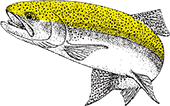WHY FLOAT FISHING WORKS
Float fishing is fast becoming the predominant means of fishing rivers and streams no matter what the species. Europeans have fished this way for years but it has only been in the last 30 or so years that North Americans have really embraced this style of fishing. In and around the Great Lakes, Float Fishing is becoming the preferred method for taking Steelhead, Salmon and Brown Trout. This simple method of fishing has made exceptionally successful anglers from average fishermen. If traditional Fly Fishing were considered one of the Finer Arts, then Float Fishing would most certainly have to be considered the Deadly Art.
The versatility that Float fishing offers is the greatest single reason why it is such an effective method. Simple adjustments in Float size, Shot patterns and leader length allow limitless variation that often is encountered in changing river conditions. Float fishing allows you the luxury of fishing every inch of the river while conventional methods force you to look for particular locations that only suit that style, causing you to pass by highly productive areas of the river that you are unable to fish.
There is no mystery to float fishing, although some would have you believe otherwise. Relative beginners to this method often out produce the seasoned professionals. The trick is to get your bait to where the fish are feeding and present it in the most unobtrusive manner possible. A properly manipulated float will give you the ability to present your bait well in advance of your shot and float. This method of presenting the bait first does not spook the fish and they readily take the offering. In the attached diagram you can see how this is accomplished by holding the float back slightly to allow the bait to kick up and run in advance of the shot and float. To accomplish this simple but stealthy presentation by a conventional method would mean fishing with little or no shot at all, making it next to impossible to get to fish in deeper water. Some rivers run so fast that your presentation must to be made well upstream from the holding fish to allow the bait to reach the proper depth at which the fish are feeding. Your position on the river is of utmost importance otherwise your bait may be passing above the fish and out of the feeding zone. The Great Lakes region along the Canada US boarder has some of the finest Steelhead and Salmon fishing in the World and a great deal of it is done in the Rivers and Streams flowing into these bodies of water. Almost all of these tributaries have good runs of both species and lend themselves well to the Float style of fishing. Most tributaries of the Great Lakes are generally very shallow and may run from two feet to as much as fifteen feet and without exception can all be fished successfully with the use of a float. Shallow running rivers require smaller floats and obviously deeper rivers will require much larger floats to support the additional weight that is required to get your bait to where the fish are. It really is that simple, not rocket science, no mystery.
There are many different shapes and sizes of floats and they all have their place, but not all floats can be used in the same place. Fast heavy running streams require proper support for the bait. Fish in these waters often hug the bottom using boulders and other structures as current breaks. Getting your bait to these fish is vital and in these conditions a seasoned angler would choose a larger more stable float able to support the added weight required to get down too the fish. Contrasting this with a shallow slower running stream the angler would likely choose a smaller more sensitive style, as less weight is required to reach these fish. There are many different water conditions, each requiring a little thought and variation in your presentation, but the learning curve is short and the rewards are many.
Fishing is not cut and dry; don’t be afraid to experiment with your tackle, presentation or bait.
What we have presented to you here, are only the basic principles of float fishing.




